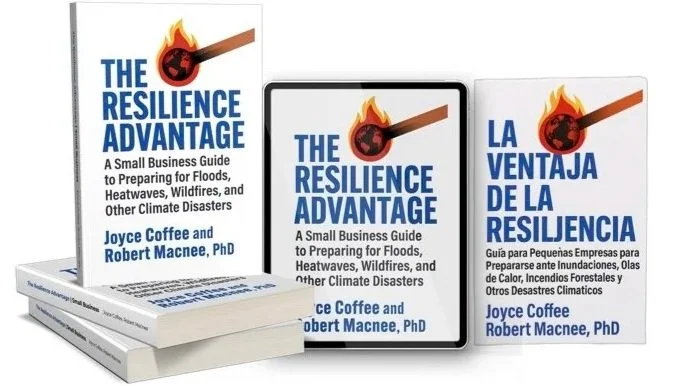
The Resilience Advantage:
Build Your Small Business
Resilience Plan in 5 Steps
Preparing for climate risks is no longer a ‘nice to have’—it’s core to long-term business resilience
The U.S.’s 34 million small businesses are the backbone of the U.S. economy—and they’re already on the frontlines of climate disruption. From heatwaves and hurricanes to power outages and rising insurance premiums, extreme weather is no longer a distant threat—it’s a daily risk. The numbers speak for themselves:
Over half of U.S. businesses in a 2025 Bloomberg survey reported weather-related financial losses in the preceding year.
40% of small businesses don’t reopen after a disaster, according to FEMA.
Rebuild by Design reports that almost every U.S. County has experienced a federally declared disaster in the past decade.
Whether you run a restaurant, repair shop, wellness studio, or landscaping crew, you deserve access to tools that help you prepare, adapt, and thrive—before, during, and after a disasters.
That’s what we call The Resilience Advantage, the competitive edge that small businesses, and the local governments that depend on them, gain when they treat preparedness as a core business strategy rather than a discretionary cost.
Free Tools for Business Climate Resilience
Looking to get started? Download our free checklists, self-assessments, and toolkits designed to help small businesses build climate resilience without the overwhelm.
These tools are organized into five easy-to-follow resilience steps below and help you:
Identify and prioritize your top local climate risks
Take concrete steps to protect people, property, and income
Organize information for insurance, emergency response, and continuity
Be ready to respond and recover—so your business can survive and thrive
Step 1: Know Your Risks
Take a few minutes to identify which types of disasters are most likely to affect your area. Here are some recommended actions:
Look up your location using any or all of the following sites:
Realtor.com’s “Environmental Risks” tool – click on My Home -> type in your address -> click on “Market Value” -> scroll down to “Environmental Risks”
Local hazard mitigation plans from your city or county
Rate your risk for each hazard as High, Medium, or Low in the Hazard Risk Assessment below, based on:
What you find in the above sites
What you’ve experienced in the past
What neighbors or local officials say is common in your area
Make quick notes to explain your thinking behind each rating—this will help guide next steps.
Step 2: Protect Your People
Your staff’s safety is the foundation of business resilience. Clear plans and visible information can help your team respond confidently in a crisis. Here are some recommended actions :
Walk through your workplace and identify what your team would need in a risk emergency. Think about how people would evacuate, where they would shelter, and how you would contact each other.
Complete the checklist below to organize and track key actions that keep employees and customers safe.
Train your staff on emergency procedures—review them at least once a year or anytime your team changes. OSHA’s Workplace Emergency Plan Guidance is a useful resource to understand what to cover: Emergency Preparedness and Response | Occupational Safety and Health Administration
Climate Resilience Matters for Small Business
The Resilience Advantage is CRC’s climate resilience guide tailored for small businesses navigating extreme weather, rising insurance costs, and supply chain disruptions.
From flooding and heatwaves to wildfires and hurricanes, this resource helps business owners protect their teams, their assets, and their long-term future. Whether you run a retail shop, restaurant, clinic, or manufacturing site, you’ll find actionable strategies to plan, adapt, stay open, and grow in the face of climate disruptions.
Written for American small business owners across all sectors—from retail and restaurants to manufacturing, healthcare, and transportation—it offers a disaster resilience blueprint for protecting people, property, and profits when the unexpected strikes. It tackles the shrinking safety net for small businesses, showing owners how to prepare financially, close insurance gaps, and create continuity plans before disaster hits. It addresses both the economic and emotional toll of climate change, offering real-world examples and encouragement to help owners “stay small but mighty” in the face of uncertainty.
Step 3: Protect Your Property & Operations
Your business assets—equipment, inventory, data, and documents—are critical to staying afloat after a disaster. Taking protective steps now can reduce damage and speed up your recovery. Here are some recommended steps:
Do a walkthrough of your space—look for equipment that could be damaged by water, wind, fire, or power loss.
Use the checklist below to prepare your physical space and digital records for risks that could harm property and disrupt operations.
Make sure multiple team members know where important systems are and how to prepare, including accessing emergency backups.
Step 4: Protect Your Profit
Disasters don’t just damage buildings—they disrupt cash flow, payroll, and customer access. Planning ahead can help your business survive unexpected revenue loss and bounce back faster. Here are some recommended actions:
Review your financial records and estimate how much cash you’d need in reserve to stay open (or reopen) after a disruption.
Complete the checklist below to make sure you are financially prepared for downtime, relocation, or emergency repairs.
Talk to your insurance agent and banker before the risk strikes to understand what is and isn’t covered—and where your recovery funding might come from.
Understand the support available to you before a disaster occurs. For example, the Small Business Association provides Disaster Loans.
Step 5: Communication & Continuity
When disaster strikes, clear communication helps keep employees, customers, and partners informed—and prevents confusion from becoming chaos. Here are some recommended actions:
Create a simple communication plan for how your team will share updates internally and externally before, during, and after a disruption.
Use the template below to list where your contact info, messaging templates, and backups are stored.
Assign roles defining who will send customer updates, contact vendors, or coordinate remote work.
Coming Soon: The Small Biz Resilience Advantage Podcast
Discover our limited-series podcast companion to The Resilience Advantage: A Small Business Guide to Preparing for Floods, Heatwaves, Wildfires, and Other Climate Disasters. The Podcast explores how small businesses are preparing for climate impacts—from wildfire recovery to heat-proofing storefronts.

What People Are Saying . . .
-
A powerful tool—clear, rigorous, and optimistic—for entrepreneurs and companies navigating climate risk.
Alex Kruzel, Corporate Strategy Advisor & Author
-
Translates decades of research into clear, actionable steps for small businesses facing climate risk.
Don Wuebbles, PhD, Coordinating Lead Author, U.S. National Climate Assessment
-
Accessible and friendly despite the intimidating topic—highly recommended for owners and the organizations that support them.
Katharine Burgess, VP, Smart Growth America
-
Gives small businesses the attention they deserve, with solutions-focused steps to continue serving their communities.
Eric Tate, PhD, Professor, Princeton University
-
Delivers what entrepreneurs need—actionable strategies to survive and thrive amid climate disruption.
Manny Flores, President & CEO, SomerCor
-
An actionable roadmap for small businesses and local leaders ready to build resilience.
Katie Wholey, Enterprise Community Partners
-
Inspiration and concrete steps to help small businesses remain anchors for their communities.
Arif Ullah, Executive Director, Anthropocene Alliance
-
Operationalizes resilience like nobody else—practical advice that is invaluable for small businesses.
Larry Susskind, PhD, MIT & Harvard
-
An accessible guide with resources, case studies, and even AI insights to strengthen resilience.
Lisa Churchill, Founder, Climate Advisory, Goldenseal
-
A timely roadmap to help businesses prepare for today’s increasingly frequent climate events.
Kevin Telford, SCORE Mentor, Retired CFO
-
A powerful blueprint, with checklists, case studies, and even AI prompts, it makes resilience tangible and achievable.
Chris Castro, EVP & Chief Sustainability Officer, Climate First Bank
-
A clear-eyed, actionable path for small businesses and leaders who can’t afford to wait.
Doug Parsons, Director, America Adapts Media







